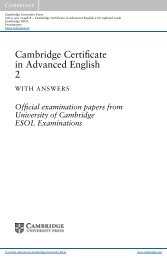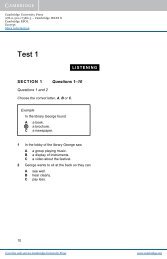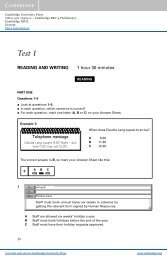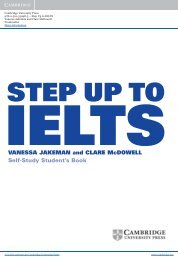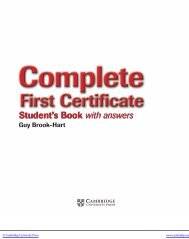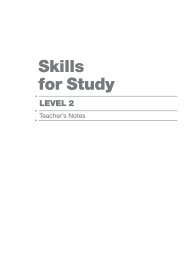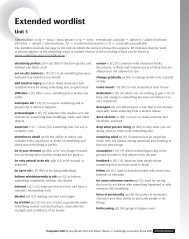Chapter 1 - Assets - Cambridge University Press
Chapter 1 - Assets - Cambridge University Press
Chapter 1 - Assets - Cambridge University Press
Create successful ePaper yourself
Turn your PDF publications into a flip-book with our unique Google optimized e-Paper software.
<strong>Cambridge</strong> <strong>University</strong> <strong>Press</strong>978-0-521-73830-9 - Physics 2 for OCRGurinder Chadha and David SangExcerptMore information<strong>Chapter</strong> 1: MomentumThe astronaut shown in Figure 1.13 is on a‘space walk’. A cable tethers him to the Shuttle. Toreturn to the craft, he pulls on the tether. This giveshim some momentum towards the spacecraft, andhe moves gently back to it.Where does this momentum come from? Has it beencreated out of nothing? The astronaut gives himselfmomentum towards the spacecraft by tugging on thetether. At the same time, his tug pulls on the spacecraftand causes it to accelerate towards him. The spacecraftgains momentum towards the astronaut. These twomomenta must be equal and opposite, so that theirsum is zero; otherwise the astronaut really will havecreated momentum out of nothing. The astronaut has asmall mass, and moves relatively quickly towards thespacecraft. The spacecraft’s mass is much greater, andso its velocity must be much smaller.Here is another momentum problem for anastronaut. Suppose he is working with tools on theoutside of the craft, and then realises that his tetherhas snapped. How can he get back to the craft?He wants to have some momentum towards thespacecraft, so he must create some momentumaway from it as well. The solution is to throw oneof his tools out into space. It has momentum awayFigure 1.13 Astronauts often carry out ‘space walks’,when they leave the shuttle to work outside. Theyhave a tether so that they don’t drift off into space.from the spacecraft, so he has momentum towardsthe spacecraft.Fortunately, astronauts now usually wearbackpacks with ‘Manned Manoeuvring Units’attached. These are rocket-powered units whichallow the astronaut to move around. The rocketblasts a jet of gas into space; this gives theastronaut momentum in the opposite direction.SAQ7 An astronaut of mass 100 kg is adrift in space.He is 10.0 m from his spacecraft. To get back, hethrows a spanner of mass 1.0 kg directly awayfrom the craft at a speed of 5.0 m s .a Explain why he moves back towardsthe spacecraft.b Calculate how long it will takeAnswerhim to reach the spacecraft.8A ball of mass 0.40 kg is thrown at a wall.It strikes the wall with a speed of 1.5 m s perpendicular to the wall and bounces off thewall with a speed of 1.2 m s .Explain the changes in momentum and energywhich happen in the collision between the balland the wall. Give numericalAnswervalues where possible.Explosions and crash-landingsThe rockets shown in Figure 1.14 rise high into thesky. As they start to fall, they send out showers ofchemical packages, each of which explodes to produceout in all directions to create a spectacular effect.Does an explosion create momentum out of nothing?The important point to note here is that the burningmaterial spreads out equally in all directions. Eachtiny spark has momentum, but for every spark, thereis another moving in the opposite direction, i.e. withopposite momentum. Since momentum is a vectorquantity, the total amount of momentum created is zero.At the same time, kinetic energy is created in anenergy has come from the chemical potential energystored in the chemical materials before they burn.9© <strong>Cambridge</strong> <strong>University</strong> <strong>Press</strong> www.cambridge.org



